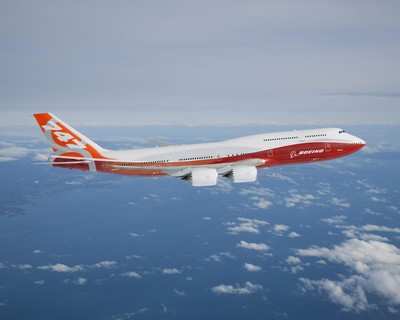Thu, Sep 15, 2011
Ruling Means Newest 747 Can Operate Under Same Separation
Distance As 747-400
The International Civil Aviation Organization (ICAO) has ruled
that Boeing's new 747-8 will be able to operate at the same
separation distances as the 747-400, designated as "heavy." ICAO, a
United Nations agency tasked with codifying principles and
techniques for international air navigation, sent a letter to all
member nations recently saying that a team of wake experts had
examined flight test and simulation data, and that it determined
that the 747-8 should remain in the same class as its predecessor
and retain the same separation distances.

A special ICAO team of experts in the field of wake vortices
from the U.S. Federal Aviation Administration (FAA), the European
Organization for the Safety of Air Navigation (EUROCONTROL), the
European Aviation Safety Agency (EASA) and the manufacturer
"examined flight test and simulation data and established safety
case arguments for approach, landing, departure, climb/descent and
cruise operations of the Boeing 747-8 relative to other aircraft,"
the ICAO letter said. "The safety case supports the assertion that
the Boeing 747-8 is safely categorized as HEAVY. Consequently, the
wake turbulence separation minima specified ... for HEAVY aircraft
should be applied."
Receiving "heavy" designation and the same separation criteria
as the 747-400 is an important accomplishment for the 747-8
program, said Todd Zarfos, vice president, engineering, 747
program. "We promised our customers that the 747-8 would be able to
operate in the same markets and routes they use for the 747-400,"
he said. "We did extensive testing to show that even though the
747-8 is longer, heavier and has a bigger wingspan than the
747-400, it does not create greater wake vortex effects. That means
that airports will be able to operate more efficiently and not have
to slow down operations to accommodate this airplane. Combined with
its lower noise footprint, the 747-8 will be a great addition to
the world's airport operations."
More News
DETRESFA (Distress Phrase) The code word used to designate an emergency phase wherein there is reasonable certainty that an aircraft and its occupants are threatened by grave and i>[...]
"General aviation is at the forefront of developing and introducing innovative technologies that will transform the entire aviation industry..." Source: Kyle Martin, Vice President>[...]
Direct Straight line flight between two navigational aids, fixes, points, or any combination thereof. When used by pilots in describing off-airway routes, points defining direct ro>[...]
Aero Linx: Women in Corporate Aviation Women in Corporate Aviation support individuals seeking career advancement and professional development in the business aviation industry. Me>[...]
“We would like to thank the many volunteers that help throughout the year to pull off the event, as well as the several reviewers, judges, and SURVICE staff that provide team>[...]
 ANN's Daily Aero-Term (04.26.24): DETRESFA (Distress Phrase)
ANN's Daily Aero-Term (04.26.24): DETRESFA (Distress Phrase) Aero-News: Quote of the Day (04.26.24)
Aero-News: Quote of the Day (04.26.24) ANN's Daily Aero-Term (04.27.24): Direct
ANN's Daily Aero-Term (04.27.24): Direct ANN's Daily Aero-Linx (04.27.24)
ANN's Daily Aero-Linx (04.27.24) Aero-News: Quote of the Day (04.27.24)
Aero-News: Quote of the Day (04.27.24)



